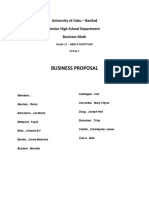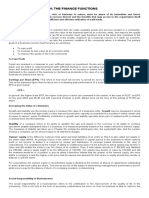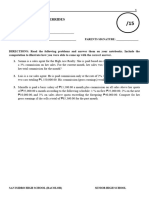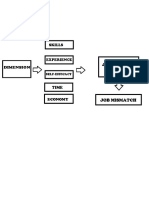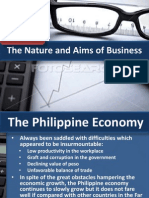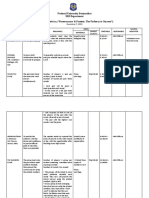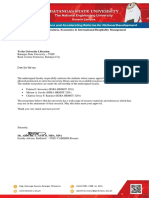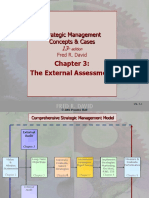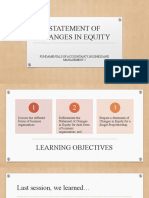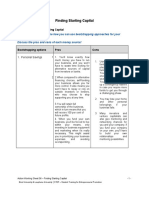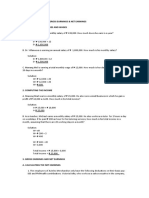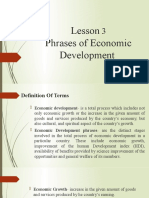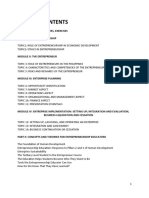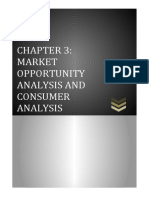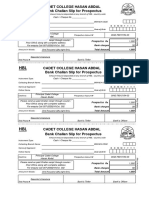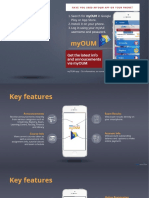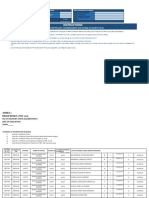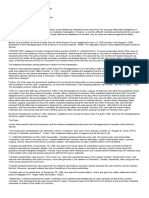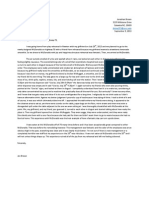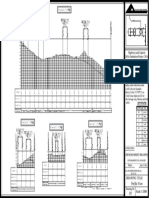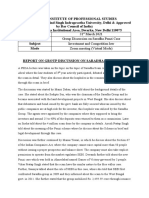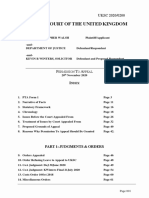Grade 12
Principles of Marketing
Module 2: The Environment and It’s Opportunities
2nd Semester, S.Y. 2020-2021
(Week 3)
Prepared by:
RAKIM L. PEREZ
Subject Teacher
MDM-Sagay College, Inc.
Office: Feliza Bldg., Marañon St. Pob 2, Sagay City
Campus: National Highway, Poblacion 2, Sagay City, Negros Occidental
Tel.# 488-0531/ email: mdm_sagay2000@gmail.com.
0
�Module 2: The Environment and It’s Opportunities
This module is focus on:
• Lesson 1 – Analyzing the Environment
• Lesson 2 – Market Research Methods
• Lesson 3 – Demand Forecasting
After going through this module, you are expected to:
1. Know the different layers of the marketing environment;
2. perform elementary environment analysis;
3. Know the components of a marketing information system;
4. put together a market research plan;
5. Know the different market categories; and
6. Have essential skills for estimating market demand both for existing and new
products.
Lesson 1. Analyzing the Environment
What I know
Activity 1. Answer the following questions:
1. Give an example of a trend that you believe is happening right now. How can an
entrepreneur take advantage of this trend?
2. Give three examples of promising products that could have worked here if only
the environment was different. Explain.
What’s In
You cannot just launch a product without first knowing anything about the world at
large. In fact, you need a quite a bit of information before you can even begin to roll
out your product idea: information about competitors’ products and strategies, the
market and its behaviors, government regulations regarding your proposed product,
alternative options, economic trends, distributors and their behaviors, and much,
much more.
What is It
Discussion
The Marketing Environment
We first begin with a breakdown of the primary elements that make up our
business environment:
1
� The internal environment refers to the business itself: what are you selling, how
your organization is set up, what your organization’s strengths and weaknesses are,
what your resources happen to be, what your company’s core values and mission are,
and essentially anything about your company that matters.
Here is a checklist of things that you may want to assess in your company’s internal
environment:
• Company cash flow. How much money does it have and how much does it
expect to flow in over time?
• Organizational structure. What personnel are available and who is accountable
for marketing initiatives?
• Assets and other resources. What property and equipment would it have
access to?
• Strategic alliances. What organizations (or even influential individuals) do the
business currently have good working relations with?
• Products and services. What are already being offered, if any?
The Competitive environment refers to the immediate industry in which your
company is doing business.
Here is a checklist of what to look out for in your competitive environment:
• Competitors. Who they are and what their respective strengths and weaknesses
may be.
• Competing products and services. What these are, what their target markets are,
and what their respective strengths and weaknesses are.
• Substitutes. What alternative products or services your markets might be
considering rather than your core product.
Michael Porter’s classic 5 forces Model is a popular used framework for
understanding the competitive structure of an industry.
The above model implies that it is not just rivalry from competitors that threaten a
firm’s existence, but even its suppliers, buyers, new players, and product substitutes.
The risk faced by a firm due to its competitors is the most obvious form of
operational risk. Competitors can spend sums of money to steal market share from the
firm or even alter the market’s perceptions about the firm’s products.
A firm also faces risks from new entrants possibly joining the industry, especially
if the industry offers attractive growth prospects.
A firm also faces risks due to substitutes that threaten to steal market share
from its industry.
2
� The firm’s own suppliers can pose a threat as well if the firm is too dependent
on these suppliers and the suppliers know it. The supplier can decide to increase their
prices or to become potential entrants to the industry as well.
If the firm is too dependent on its buyers, the buyers may sense this. They might
band together and threaten the firm through additional demands. Buyers may also
become potential entrants into the industry if they feel that entering the industry is a
simple matter after all.
The internal and the competitive environments form what is often referred to as
the micro environment of a business. However, looming even larger would be the
macro environment, which is composed of environmental variables that are typically
beyond the control of any organization.
There are far too many elements in the macro environment. That is why there are
mnemonics, which can help break down this complexity into more digestible parts. One
of the most popular mnemonics is PEST, which stands for:
• Political. What are the different pieces of legislation, including tax rates, that
affect the business? How likely is it for the government to intervene in the
industry? How stable is the working environment in terms of political stability and
overall predictability?
• Economic. Is the market growing or shrinking? What is savings rate of the
population, and how is the employment situation? Is the consumer spending
increasing or decreasing? Do people feel that their quality of life is improving?
How volatile is the exchange rate, the interest rate, and other essential
indicators?
• Social. Is the population growing or shrinking? Is it aging or the broad
demographic is getting younger? What are their interests? What are the lifestyles
that they lead? How do the markets behave, especially in terms of assessing and
consuming your industry’s products?
• Technological. What are the new technologies that are changing the business
landscape? What new ideas are gaining momentum? What new products and
practices could threaten to make your current obsolete?
Lesson 2. Market Research Methods
The Market Information System (MIS) is the people, equipment, and procedures
used to gather, sort, analyze, evaluate, and distribute needed, timely, and accurate
information to marketing decision-makers. The components of a market information
system are:
3
� • Internal Records. This refers to documents in the company’s order-to-payments
cycle, such as invoices, shipping orders, etc. It also avails documents and
resources that comprise the sales information system, such as sales forecasts,
information from sales personnel, and information culled from automated sales
system.
• Marketing Intelligence. The set of procedures and sources used by managers
to obtain everyday information about developments in the marketing
environment. This includes newspapers, intermediaries, social networks, trade
conferences, suppliers, ad agencies, the reverse engineering of competitor
products, published reports, purchased information, etc.
• Market Research. The systematic design, collection, analysis, and reporting
data and findings relevant to a specific marketing situation facing the company.
This includes taking surveys or conducting exploratory studies of a market.
Market research is scientific in nature, utilizing the scientific method in order to
gain insights on how to solve real world problems. In this case problems usually involve
resolving questions about how to best provide value to customers or about
understanding how consumers behave.
Research Process
Market research is primarily concerned with understanding the nature of a
market. Some of the questions that a market research typically seeks to answer are:
• Who are our typical buyers?
• Where do our buyers come from?
• How big is our market?
• What are our consumers’ aspirations?
• How do our customers shop and with whom?
• What do our customers buy?
• Why do customers refuse to buy our products?
The processes involved in conducting market research can be outlined as
follows:
• Define the Problem and Research Objectives. The problem should not be
defined too broadly nor too narrowly. In fact, great care should be taken when
defining the problem as this will determine the very nature and direction of the
research.
• Develop the Research Plan. The research plan is composed of the following
components:
o Data Sources. Secondary data involves the gathering of prior and
related research works since it is possible that other parties have already
developed useful findings on the matter being studied. Primary data
involves actually undertaking the research itself in order to get first-hand
knowledge on the matter.
o Research Approaches. Research can be conducted through observation,
focus groups, survey research, behavioral data, and experimental
research.
o Research Instruments. These include questionnaires or mechanical
instruments such as video recorders.
o Sampling Plan. This addresses (1) sampling unit (who is to be
surveyed?), (2) sampling size (How many people should be surveyed?),
and (3) sampling procedure (how should they be chosen?).
4
� o Contact Methods. Contact with the survey sample could be done via
personal or impersonal means. Methods include the use of mail
questionnaires, telephone surveys, personal interviews, or the internet.
• Collect the information. This involves the actual gathering of the data. For
surveys, for instance, this would involve mobilizing a suitable number of field
workers who will then find respondents according to the sampling plan. For a
research that involves the conduct of interviews, field workers will have to be
trained first in order to be responsive enough to properly interact with
respondents.
• Analyze the data. Once all the data has come in (whether in the form of surveys,
interviews, group discussions, or through electronic means such as online
ballots), the next step involves the actual processing of the data. Quantitative
data can be processed through software such as statistical packages, while
qualitative data (such as interviews) can be processed through data reduction or
summarization techniques.
• Present the findings. Once processed, the data can now become a useful
information. However, its usefulness will still be a function of how well it is
presented. Qualitative information, for instance, may best be digested in the form
of graphs and charts so that trends can be more easily seen. Qualitative data, on
the other hand, may best be presented in the form of clear examples and case
studies.
Research Methods
As a rule, it is generally expensive to collect primary data. That is why firms with
smaller budgets generally resort to accessing secondary data and extrapolating
conclusions from them.
Observation is best to use when trying to answer questions involving how a
market behaves. Thus, observation works for situations such as the following:
o Identifying which section of a supermarket a shopper typically visits first;
o Finding out how much toothpaste a consumer applies to his toothbrush per use;
and
o Determining how long a type of customer typically stays in a quick-service food
outlet.
Surveys research is best to use when trying to determine a market’s opinions,
perceptions, and basic demographic data. Surveys are best for situations such as the
following:
o Identifying discrete factual data such as the person’s age, gender, level of
education, place of residence, occupation, hobbies, etc;
o Knowing a person’s opinions about a particular product; and
o Determining a person’s likes and dislikes.
Focus groups are useful for gathering strong opinions and beliefs from a given
target market. Fucos groups are actually a subset of survey research except that, unlike
surveys which tend to be composed of individual opinions, focus groups are composed
of set of people who are placed together in a closed, controlled environment to discuss
a product or issue with a moderator. The idea here is that by getting the group to
discuss and critique their own opinions, the resulting answers to questions would more
reliably reflect their reality as compared to answers obtained via surveys or interviews.
Experimental research is a means of answering a hypothesis through the use
of an experiment. While the bulk of Philippine market research efforts typically
gravitates toward the use of surveys and field interviews, experiments are an under-
appreciated method for validating issues of casuality.
Bias is a tendency of data to skew toward a particular direction. It is normal for
any research to have a certain amount of bias, but it is the job of researchers to
minimize bias to the best of their abilities. Bias normal for researches because, by
5
�definition, a sample is a small portion of a population that tries to explain the entire
population but this sample may not perfectly represent the population.
Other examples of biases:
o Phone or online interviews. Respondents may not take these interviews too
seriously because of the lack of actual contact.
o Mail or email surveys. Only a particular kind of respondent may be motivated to
actually mail the surveys back.
o Questions regarding income. Respondents may either not actually know what
their incomes are or post a different figure due to fear of divulging such a
personal bit of information.
Lesson 3. Demand Forecasting
The Market
The market for a product can be categorized as follows:
o Potential Market. These are those who express some level of interest in a
product.
o Available Market. Is the subset of the potential market who have interest,
income, and access to the product.
o Qualified Available Market. This is a further refinement of the available market
since it may be possible that those who have interest, income, and access,
nevertheless cannot get the product due to technical issues such as laws, or
distribution constraints.
o Served Market. Also known as the serviceable available market. This is the
market that the company can actually service with its current state of logistics.
o Penetrated Market. This is the subset of the market that is already actively using
the product.
The market demand for a product or service, on the other hand, is the total
volume of the sales that is generated by a defined customer group in a defined
geographical area, time period, and marketing environment under a defined marketing
program. It is a factual number, meaning that market demand by definition is something
that has already happened.
Forecasting Demand for an Existing Product
If the firm already has an existing product in the market, then estimating what the
future demand for the product would be will be a matter of assessing the following:
o Listening to what people say. This includes salesforce opinions, expert
opinion, and buyers’ opinions.
o Assessing what people have done. This generally involves the statistical
analysis of past-sales data or related data.
6
� o Salesforce opinion. Generally involves getting a composite of what each sales
person, sales team, or sales unit estimates to be its possible sales volume for the
upcoming period based in past history.
o Expert opinions. Regarding the potential market size and the acceptability of
the proposed product can be taken from industry watchers or people with
experience in the industry. This can include technical resource people from the
department of Trade and Industry, industry veterans, observers, and insiders.
o Time Series analysis. Uses data from previous periods to forecast the following
period’s sales.
o Regression analysis. Is a more sophisticated statistical method for predicting
an outcome based on multiple possible factors. A regression model works by
using statistical models to determine the correlation between a hypothetical
cause and the effect, again based on historical data.
Forecasting Demand for a New Product
Predicting the demand for a new product is far more challenging than predicting
for an existing or established product. In fact, to be very candid, there is no clear way to
predict the demand for a product that has never yet seen the light of the market day.
A common technique for predicting demand for a new product is through the use
of the Chain ratio method. It is a method with a very simple operational logic and
requires simple math abilities. The premise here is that if you define your target market
well enough, then you can calculate how big this market can be.
Generally, the best way to predict demand for a new product is to first set up a
Test Market for it – for launching the product in a smaller location and conducting an
exact but smaller-scale market strategy in order to assess the actual sales that will
occur. These figures can then be extrapolated towards the larger market as a whole.
However, not all firms can afford test marketing.
What’s More
ACTIVITY 2. Put your answers on a separate yellow pad paper.
1. Give three examples of products and their potential substitutes.
Product Potentials substitutes
2. What is the difference between an opportunity and a threat? Site examples of
these for a particular industry.
What I Can Do
Activity 3. Write it on a separate of yellow pad paper.
1. State an observation about how people behave when they are buying or using a
particular product. Ideally, it should be something that you think not too many
people have noticed.
Product:
Observation:
7
� 2. Discuss a product that you thought would do well but did not. What made you
think it would do well? What do you think happened?
Product:
Why did you think that it would do well:
What do you think happened:
Assessment
Activity 4: Answer the following questions and write your answer on separate
yellow pad paper.
1. Explain why you cannot exactly rely on statistical methods to predict long-term
sales for your products.
2. Assess what may be the best research methodology (Survey, interview, or
others) in identifying the likes and dislikes of an individual consumer. Explain.


